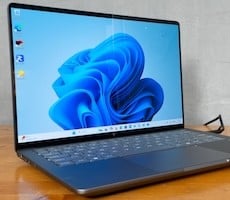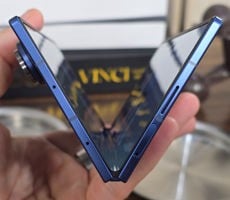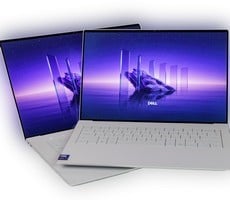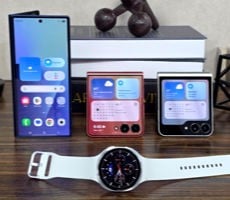Galaxy Z Fold7 Review: Samsung’s Stunning Folding Phone Revival
| Samsung Galaxy Z Fold7 - Starting At $1,999, Find It On Amazon The Galaxy Z Fold7 is Samsung’s best folding phone yet. The ultra-thin and light design is outstanding and the software is feature-rich, though its battery life is middling and telephoto performance is lackluster. |
|||

|

 |
||
Despite having pioneered folding phones, Samsung lost its edge over the last few years. By the time the Galaxy Z Fold6 launched last summer, the company was seriously lagging behind Chinese manufacturers like Oppo, Honor, and Xiaomi – and even Google here in the US – when it comes to design and specs. However, the Galaxy Z Fold7 that Samsung recently revealed at its Unpacked event brings the company back into the fold.
But while it now generally matches the competition in terms of thickness (8.9mm folded, 4.2mm unfolded), weight (215g), and form factor, the Z Fold7 lacks the silicon-carbon battery tech and flagship-grade telephoto cameras found in Chinese folding handsets. It also drops support for the S Pen, which is a bummer. This is odd, considering Samsung keeps using the word “ultra” to market the Z Fold7. And then there’s the price: $1,999 is a big price tag. Regardless, aside from its smallish 4,400mAh battery and basic 10MP 3x telephoto lens, did Samsung make any other hardware compromises in the name of thinness and lightness? How does Qualcomm’s Snapdragon 8 Elite perform in such a slim chassis?
And, taking Samsung’s broad ecosystem and feature-rich software into account, is the Galaxy Z Fold7 the new book-style folding phone to beat? As you've probably noticed, there's an Editor's Choice logo in our summary here above (for good reason), so let’s find out more in our full review.
Galaxy Z Fold7 Hardware, Design, And Build Quality
For too long, Samsung made thick, narrow, tall, and awkwardly proportioned book-style folding phones while Chinese manufacturers were striving to make folding phones that look and feel no different than a bar-style flagship when folded. The Galaxy Z Fold7 changes all this. With a thickness of just 8.9mm folded and 4.2mm unfolded, it matches the previous thinness champ, the Oppo Find N5 (successor to the Oppo Find N3 or OnePlus Open).It’s hard to convey in words, photos, or even video how incredibly thin and light the Z Fold7 actually is, and how comfortable it is to hold. Just like with the Galaxy S25 Edge, you need to experience this device in person to really understand it. Plus, the Z Fold7’s squared off design looks fantastic. Build and material quality are top notch, and the hinge feels incredibly solid yet silky smooth, and offers just the right amount of resistance.
The Z Fold7’s vertical camera pod reverts to the Galaxy Z Fold5’s design, with three silver-rimmed lenses jutting from a pill-shaped island, and the flash mounted to the side, flush with the rear glass. Like with the Galaxy S25 Edge, this camera bump is thicker (about 6mm) then the unopened handset itself, and since it’s mounted in the top left corner of the back panel, the Z Fold7 wobbles like a drunken sailor when placed on a flat surface.
You can get the Z Fold7 in four different hues: Blue Shadow, Silver Shadow, Jet-black, and Mint (a Samsung store exclusive). We’re glad Samsung is offering fun colors again because our Blue Shadow review unit is particularly striking.
But, before we continue, don't miss our hands-on video:
Galaxy Z Fold7 Specs And Features
| CPU Platform |
Qualcomm Snapdragon 8 Elite for Galaxy |
| Display | 8.0" 2k LTPO Dynamic AMOLED 2x, 2184x1968 res, 1-120Hz + 6.5" 1080p LTPO Dynamic AMOLED 2x, 2520x1080 res, 1-120Hz |
| Memory | 12/16GB |
| Storage | 256GB/512GB/1TB UFS 4.0 |
| Rear-Facing Cameras | 200MP 1/1.4” f/1.7 Main OIS, Omni-Directional PDAF - 12MP f/2.2 120º Ultra-Wide PDAF - 10MP f/2.4 3x Telephoto OIS, PDAF |
| Front-Facing Cameras | 10MP f/2.2 18mm (inner) - 10MP f/2.2 24mm (outer) |
| Video Recording | Up
to 8K @ 30fps, 4K @ 60fps, 1080p @ 120fps, 1080p slow-mo |
| Battery | 4,400mAh, 25W wired charging, 15W wireless charging, 4.5W reverse wireless |
| OS | Android 16 with One UI 8 |
| Dimensions | Unfolded: 158.4 x 143.2 x 4.2mm - Folded: 158.4 x 72.8 x 8.9mm |
| Weight | 215 grams |
| Connectivity | 802.11be Wi-Fi 7, Bluetooth 5.4+LE, NFC, UWB, USB-C, LTE, 5G (sub-6GHz and mmWave) |
| Colors | Blue Shadow, Silver Shadow, Jet-black, Mint |
| Pricing: | Find The Galaxy Z Fold7, Starting At $1999 |
Galaxy Z Fold7 Display Quality
Samsung has upgraded the Galaxy Z Fold7’s screens for 2025. You’re now getting a 6.5-inch FHD+ (2520 x 1080 pixels. 422ppi) cover display with a standard 21:9 aspect ratio, alongside an almost square 8-inch QXGA+ (2184 x 1968 pixels, 368ppi) folding main screen. These are LTPO AMOLED panels (Dynamic AMOLED 2X) with a 120Hz adaptive refresh rate, HDR10+ support, and 2600 nits of very punchy peak brightness.Unfortunately, the Z Fold7 also lacks S Pen support. Samsung claims that the ultra-thin design doesn’t leave enough space to include a digitizer, but the Oppo Find N5 is about the same thickness as the Z Fold7, and does support an active stylus on both its inner and outer screens.
Galaxy Z Fold7 Camera Performance And Image Quality
Samsung’s Galaxy Z Fold7 boasts the same shooters as the Galaxy S25 Edge, but supplemented by the Galaxy Z Fold6’s telephoto. Sadly, that 3x telephoto doesn’t make a big difference. The Z Fold7 struggles just as much as the S25 Edge when zooming. On the plus side, that 200MP main sensor is solid, and the Snapdragon 8 Elite’s powerful ISP is more than capable of squeezing the most image quality from these cameras.Zooming is where things fall apart. While on paper, the Z Fold7 tops out at 30x magnification (3x optical plus 10x digital), it doesn’t perform any better than the Galaxy S25 Edge, which doesn’t have a telephoto camera and tops out at 10x (digital) magnification. The Z Fold7’s 10MP 3x telephoto doesn’t seem to improve zoom performance. Samsung isn’t using sensor fusion, or any clever AI zoom algorithms like what we saw on the OnePlus 13.
Shooting modes include macro, portrait, night, pro, 200/50MP (main only), panorama, food, macro video (up to 4k 60fps), ultra steady (1440p/1080p 60/30fps), portrait video (4k/1080p 30fps), pro video (8k 30/24fps / 4k 60/30/24fps / 1080p 120/60/30/24fps), slow motion (4k 120fps, 1080p 240/120fps), hyperlapse (4k/1080p 30fps), Single Take, and Dual Rec (4k/1080p 30fps) – which lets you combine any two of up to four cameras.
Next up: audio fidelity, general performance, and battery life results...



























